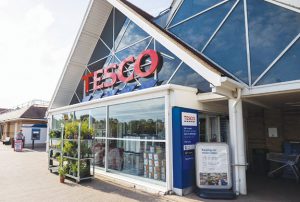Say it quietly: Inflation isn’t all bad for supermarkets. Amid predictions of the cost-of-living crisis devastating the consumer industries, Britain’s biggest retailer, Tesco Plc, reported better-than-expected first-half sales, as higher prices and Brits enjoying themselves during the summer heatwave boosted revenue. Tesco said UK like-for-like sales rose 0.7% in the six months to Aug. 27, compared with expectations of a 0.07% decline.
Rising prices tend to inflate the value of supermarket sales. As long as they can control the decline in sales volume, they should automatically see an uplift in same-store sales compared with the year earlier.
Even as Tesco Chief Executive Officer Ken Murphy said the supermarket was raising prices “a little bit less and a little bit later than the market,†it can’t escape the helpful impact of inflation on sales. It may also be picking up shoppers trading down from pricier rivals. Although it is more expensive than Aldi and Lidl, its broader range of products and bigger car parks help to offset that disadvantage. That said, an inflationary environment is not without its challenges.
As Britons watch every penny amid soaring household energy bills, they are more inclined to shop around and visit the UK arms of the German discounters. Last month, data provider Kantar said that Aldi had overtaken Wm Morrison Supermarkets Ltd. to become Britain’s fourth-biggest grocer by market share.
Consequently, Tesco is having to keep its prices rising less than the broader market — where food price inflation is into the double digits — in an effort to stem the tide of customers to competitors. As well as matching the price of hundreds of items to Aldi, and limiting special offers to members of its Clubcard loyalty program, the company said that the prices of more than 1,000 everyday items would remain stable until 2023.
Analysts at Bernstein have estimated that Tesco is 15% more expensive than Aldi and Lidl. But the CEO said that the company had cut the differential to well below this figure over the last 12 months.
Still, it can’t be complacent. Aldi has said it will do whatever it takes to maintain its price advantage. And Tesco’s efforts to control prices, together with pressure on the grocer’s own costs from wages and energy, are taking their toll on profits. Even as Tesco said full-year free cash flow from its retail operations would be at the top of its £1.4 billion ($1.6 billion) to £1.8 billion range, it now expects operating profit of between £2.4 billion and £2.5 billion in the year to the end of February 2023.
 The Gulf Time Newspaper One of the finest business newspapers in the UAE brought to you by our professional writers and editors.
The Gulf Time Newspaper One of the finest business newspapers in the UAE brought to you by our professional writers and editors.
